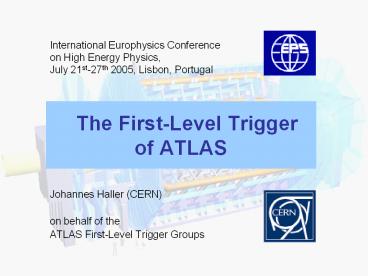The%20First-Level%20Trigger%20of%20ATLAS - PowerPoint PPT Presentation
Title:
The%20First-Level%20Trigger%20of%20ATLAS
Description:
International Europhysics Conference on High Energy Physics, July 21st-27th 2005, Lisbon, Portugal The First-Level Trigger of ATLAS Johannes Haller (CERN) – PowerPoint PPT presentation
Number of Views:92
Avg rating:3.0/5.0
Title: The%20First-Level%20Trigger%20of%20ATLAS
1
The First-Level Trigger of ATLAS
International Europhysics Conference on High
Energy Physics,July 21st-27th 2005, Lisbon,
Portugal
- Johannes Haller (CERN)
- on behalf of the
- ATLAS First-Level Trigger Groups
2
Triggering at the LHC
s
rate
bunch crossing rate 40 MHz total interaction
rate 1 GHz event size 1.5 MB
total interaction rate
affordable 300 MB/s storage rate 200 Hz ?
online rejection 99.9995
23 min. bias events 1725 particles/BC
e.g. Higgs ? ZZ ? 2e2m
storage rate
discoveries
- powerful trigger needed
- enormous rate reduction
- retaining the rare events in the very tough LHC
environment
ET
3
ATLAS Trigger System
3-Level Trigger System
- LVL1 decision based on data from calorimeters and
muon trigger chambers synchronous at 40 MHz
bunch crossing identification - LVL2 uses Regions of Interest (identified by
LVL1) data (ca. 2) with full granularity from
all detectors - Event Filter has access to full event and can
perform more refined event reconstruction
hardware
2.5 ms
software
10 ms
sec.
this talk
LVL1 Calorimeter Trigger Muon Trigger
Central Trigger
4
LVL1 Calorimeter Trigger
to DAQ
- example e/g algorithm
- goal good discrimination e/g ? jets
- identify 2x2 RoI with local ET maximum
- cluster/ isolation cuts on various ET sums
Input/output data
DAQ RODs
2 ROD crates
to LVL2
2 JEP crates
Analogue tower sums0.1 x 0.1 (7200)
to CTP
feature types/ positions
e/?, ?/had Clusters (CP)
to CTP
8 PPr crates
4 CP crates
- electronic components (installed in counting room
heavily FPGA based ? flexibility) - PPr digitisation of analogue signals from
calorimeters and bunch crossing ID - JEP jet finding and energy sums
- CP e/g and t/ had. cluster finding
- output
- at 40 MHz multiplicities for e/g, jets, t/had
and flags for energy sums to Central Trigger
(CTP) - accepted events position of objects (RoIs) to
LVL2 and additional information to DAQ
5
LVL1 Muon Trigger
algorithm
- dedicated muon chambers with good timing
resolution for trigger - Barrel ?lt1.0 Resistive Plate Chambers
(RPCs) - End-caps 1.0lt?lt2.4 Thin Gap Chambers
(TGCs) - local track finding for LVL1 done on- detector
(ASICs)
- looking for coincidences in chamber layers
- programmable widths of 6 coincidence windows
determines pT threshold
6
LVL1 Central Trigger
multiplicities of m for 6 pT thresholds
multiplicities of e/g, t/h, jet for 8 pT
thresholds each flags for SET, SET j, ETmiss
over thresholds
Central Trigger Processor (CTP)
example trigger menu
LVL1 Menu 2x1033cm-2s-1
MU20 0.8
2MU6 0.2
EM25i 12.0
2EM15i 4.0
J200 0.2
3J90 0.2
4J65 0.2
J60xE60 0.4
TAU25xE30 2.0
MU10EM15i 0.1
Others 5.0
Total rate (kHz) 25
big uncertainties on predicted rates
7
ATLAS Combined Test Beam
setup at CERNs SPS H8 beam-line (2004)
beam (p, µ, e, p, g) Ebeam (1 to 360) GeV
L1Muon setup
- full scale ATLAS slice, all sub- detectors
- test of prototypes and final modules
- periods of 25ns structured beam
- (like LHC)
- aim to establish full trigger and data
acquisition chain
barrel chambers
end-cap chambers
8
LVL1 Trigger at the Test-Beam
- all trigger, timing, control and readout paths
successfully established
- full LVL1 trigger chain established for the
first time
- LVL1 triggered the readout of all sub-detectors
- LVL1 latency projected to ATLAS 2.13 µs
signal distribution at test-beam
Muon Trigger
Calo Trigger
all sub- detec- tors
CTP latency 95 ns at test-beam 125 ns (not
optimized)
9
Test-Beam Results Muon Trigger
end-caps (TGCs)
barrel (RPCs)
threshold efficiency after chamber shifting
position in precision muon chambers vs. position
in RPCs
efficiency and BCID
- Triggered Bunch
- Next Bunch
- Previous Bunch
- total efficiency
- pT threshold 6
? pT threshold 5 ? pT threshold 4
- nice correlation between RPC and MDT position
measurement - trigger efficiency at test-beam (3/4, phi)
99.4 - efficiency for correct identification of bunch
crossing 99.5
- chamber was shifted to emulate the effect of
deflection in magnetic field - coincidence algorithm works
- big timing margin where e(correct bunch) high and
e(bunches before and after) tiny
10
Test-Beam Results Calorimeter Trigger
- a full slice of the calorimeter trigger system
was installed 1 of final capacity - checks of data consistency very successful
counting room reality
- good correlation of energy values measured in
calorimeter and received in CP module - no event below e.m. trigger threshold of 20 GeV
- ? calorimeter trigger did work
11
Summary
- The trigger and its performance are of paramount
importance at the LHC - The First Level Trigger of ATLAS is based on
calorimeters and dedicated muon chambers and
reduces the event rate to 75 kHz - Successful test of the First Level Trigger system
at the ATLAS Combined Test Beam - Status Prototypes of all types of modules and
all ASICs validated mass production started - Road to data-taking at the LHC
- muon trigger chamber integration already started
- CTP installation September 2005
- calorimeter trigger installation starts in
September 2005 - first cosmic ray runs with a subset of detectors
early 2006 - ATLAS expects to be ready for first pp
collisions in 2007































